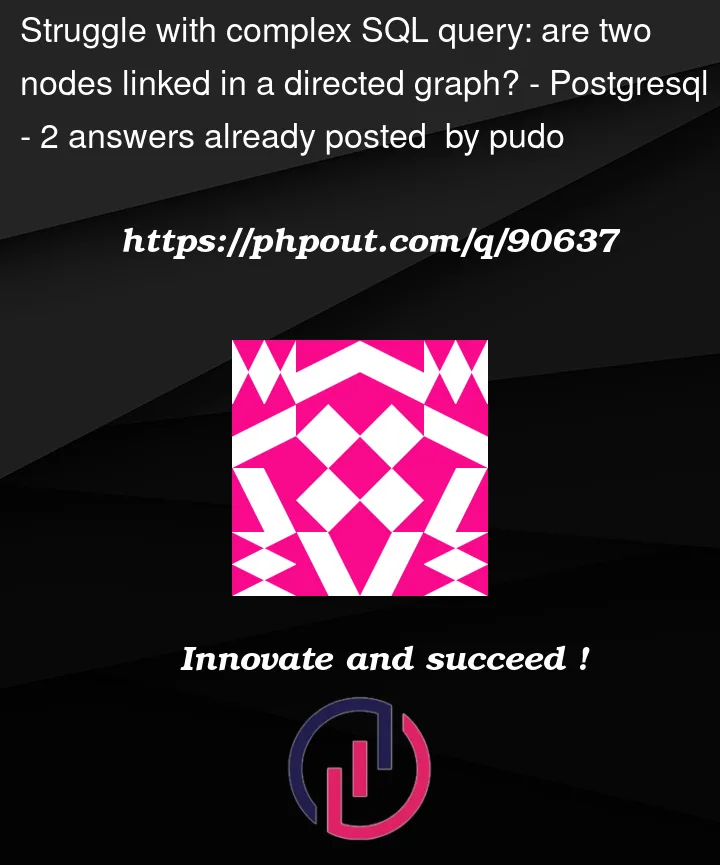I’ve been stuck on this SQL query for a day now, so I’m throwing it up here and would appreciate any advice others can give.
This is the problem: I want to generate a set of pairs of tags (named entities from articles), a and b, ordered by how many articles they co-occur in. This is relatively simple. However, there’s a twist: the query should also check another table, link, to see if there’s already an existing link between both tags. A link is a directed edge, ie. two tags could be connected either a->b or b->a.
As a minimum, I want to filter out all links where a and b are already connected – but a better implementation would allow me to return unfiltered pairs, with the type of the link whereever a link exists.
Here’s the basic pair-generating query, which works as expected:
SELECT
l.cluster AS left_id,
l.cluster_type AS left_type,
l.cluster_label AS left_label,
r.cluster AS right_id,
r.cluster_type AS right_type,
r.cluster_label AS right_label,
count(distinct(l.article)) AS articles
FROM tag AS l, tag AS r
WHERE
l.cluster > r.cluster
AND l.article = r.article
GROUP BY l.cluster, l.cluster_label, l.cluster_type, r.cluster, r.cluster_label, r.cluster_type
ORDER BY count(distinct(l.article)) DESC;
CTE-based approach
Here’s a sort of solution to the sub-problem of getting all the pairs where a link exists:
WITH links AS (
SELECT
greatest(link.source_cluster, link.target_cluster) AS big,
least(link.source_cluster, link.target_cluster) AS smol,
link.type AS type
FROM link AS link
)
SELECT l.cluster AS left_id, l.cluster_type AS left_type, l.cluster_label AS left_label, r.cluster AS right_id, r.cluster_type AS right_type, r.cluster_label AS right_label,
count(distinct(l.article)) AS articles,
array_agg(distinct(links.type)) AS link_types
FROM tag AS r, tag AS l
JOIN links ON l.cluster = links.big
WHERE
l.cluster > r.cluster
AND l.article = r.article
AND r.cluster = links.smol
GROUP BY l.cluster, l.cluster_label, l.cluster_type, r.cluster, r.cluster_label, r.cluster_type
ORDER BY count(distinct(l.article)) DESC
But this doesn’t handle showing unlinked pairs, or showing both linked and unlinked pairs. Maybe there’s some way of sub-querying the links CTE in the main query that would handle non-linked pairs?
Table definitions
CREATE TABLE tag (
cluster character varying(40),
article character varying(255),
cluster_type character varying(10),
cluster_label character varying,
);
CREATE TABLE link (
source_cluster character varying(40),
target_cluster character varying(40),
type character varying(255),
);
Example data
tag:
"cluster","cluster_type","cluster_label","article"
"fffcc580c020f689e206fddbc32777f0d0866f23","LOC","Russia","a"
"fffcc580c020f689e206fddbc32777f0d0866f23","LOC","Russia","b"
"fff03a54c98cf079d562998d511ef2823d1f1863","PER","Vladimir Putin","a"
"fff03a54c98cf079d562998d511ef2823d1f1863","PER","Vladimir Putin","b"
"fff03a54c98cf079d562998d511ef2823d1f1863","PER","Vladimir Putin","d"
"ff9be8adf69cddee1b910e592b119478388e2194","LOC","Moscow","a"
"ff9be8adf69cddee1b910e592b119478388e2194","LOC","Moscow","b"
"ffeeb6ebcdc1fe87a3a2b84d707e17bd716dd20b","LOC","Latvia","a"
"ffd364472a999c3d1001f5910398a53997ae0afe","ORG","OCCRP","a"
"ffd364472a999c3d1001f5910398a53997ae0afe","ORG","OCCRP","d"
"fef5381215b1dfded414f5e60469ce32f3334fdd","ORG","Moldindconbank","a"
"fef5381215b1dfded414f5e60469ce32f3334fdd","ORG","Moldindconbank","c"
"fe855a808f535efa417f6d082f5e5b6581fb6835","ORG","KGB","a"
"fe855a808f535efa417f6d082f5e5b6581fb6835","ORG","KGB","b"
"fe855a808f535efa417f6d082f5e5b6581fb6835","ORG","KGB","d"
"fff14a3c6d8f6d04f4a7f224b043380bb45cb57a","ORG","Moldova","a"
"fff14a3c6d8f6d04f4a7f224b043380bb45cb57a","ORG","Moldova","c"
link
"source_cluster","target_cluster","type"
"fff03a54c98cf079d562998d511ef2823d1f1863","fffcc580c020f689e206fddbc32777f0d0866f23","LOCATED"
"fe855a808f535efa417f6d082f5e5b6581fb6835","fff03a54c98cf079d562998d511ef2823d1f1863","EMPLOYER"
"fff14a3c6d8f6d04f4a7f224b043380bb45cb57a","fef5381215b1dfded414f5e60469ce32f3334fdd","LOCATED"




2
Answers
I think what you want is a
LEFT OUTER JOINfrom tags to links, which doesn’t filter out tag pairs without a link but annotates them with the link when it exists.The max() business is me being lazy about fixing the fact that the query doesn’t know there’s at most one link per tag pair so it needs an aggregate function.
To account for the possibility of links at a depth > 2 (the current
linktable only has a linking of depth2:fff03a54c98cf079d562998d511ef2823d1f1863 > fe855a808f535efa417f6d082f5e5b6581fb6835), you can use a recursivecteto build thesource_clusterpaths to eachtarget_cluster, which can then be flattened andleft joined onto your main query:See fiddle.